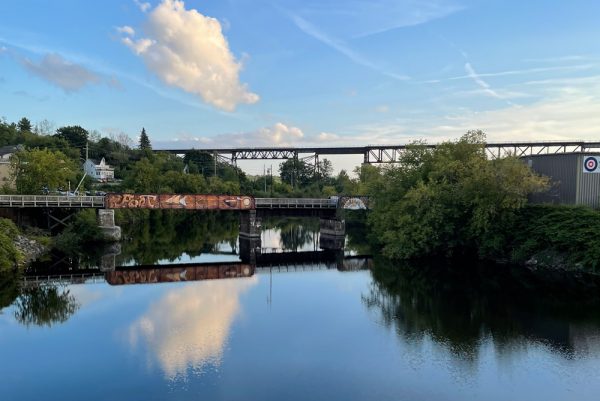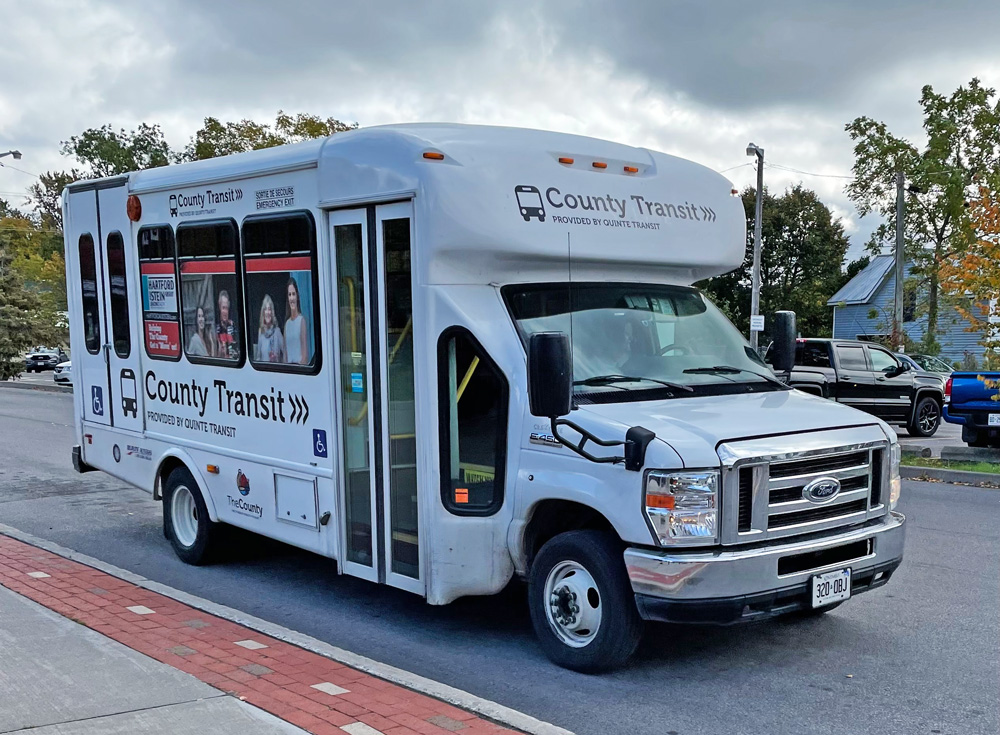It was summer 2022, and I was eager to get away and mentally escape the pandemic. Some wilderness would be nice, forest bathing in cottage country, perhaps some swimming and hiking. In previous years I had rented a car for such a journey, but in summer 2022 car rentals were wildly expensive or unavailable.
Should expensive or unavailable rental cars be an issue? Not really. Rural Ontario is beautiful and it should not only be possible to visit by transit, but normal to do so. But is it?
I decided to challenge my perception that it was impossible to visit rural Ontario by transit, and started to do some research. Bus or train were fine, but my preference was for the latter. I immediately daydreamed about the return of Ontario Northland, while discovering that Via Rail offers service to Parry Sound.
I knew little about Parry Sound, other than it’s a small town in cottage country. I learned that there were harbour cruises, bike rentals, hiking trails, beaches, a heritage garden, and brewery all within walking distance of each other. I figured this would be a nice little adventure and discovery for a few days’ break. I mentioned my research to a friend, a fellow urban planner and also a bit of the adventurous type. We’re both “extreme users” when it comes to transit – we’ll make it work even if the service isn’t great or frequent.
My friend signed on to the idea, and went on to tell me about research she’d conducted. Railways were, at one time, the only reliable way to escape to cottage country from Toronto. Stations like Muskoka Wharf were built beside the water so you could take the train right to your boat. And well-appointed resort hotels were sprinkled along rail routes. She referenced a PhD dissertation by Geoffrey Shifflett, which notes that the extension of the Northern Railway to Gravenhurst was partly funded by the City of Toronto. Imagine!
I was excited and went online to try to book our return journey from Toronto to Parry Sound on Via Rail. However, Via’s website would not allow a return journey — only a one-way journey. No explanation was presented. Perplexing.
Not one to give up, I started searching out the location of Via properties. I found a link that showed there are two rail stations: Parry Sound and Parry Sound South. One handles northbound journeys, and the other southbound journeys. They’re located about a 15 minute walk from each other in downtown Parry Sound. I’ve taken trains in several countries, and have had situations where I’ve booked a return ticket to a town, and been notified clearly on the ticket that the inbound and outbound journeys would be through different stations. Why does Via Rail not do this for Parry Sound? Frustrating.
All transit services in the province should be easy to navigate and easy to connect between — online and on-the-ground. Something equivalent to airline “codesharing,” except all transit should be on one “codeshare.” Sadly, different municipalities, transit agencies, and companies have their own online presences, symbols, graphics, maps, payment schedules, and options, and they don’t connect with each other. Information should be readily available about how all the transit options in the province are connected to each other. Surely the provincial government should provide this and maintain it, but it doesn’t appear to exist.
Though the (unnecessary) puzzle was solved, the 2 trains per week service nevertheless made it inconvenient for us. I had to spend more time trying to determine if there was another way. I eventually found that we could take an Ontario Northland bus from Parry Sound back to Barrie, and then switch to a GO Train back to Toronto. While this is possible, it could be better connected. The train stations in Parry Sound are downtown, but the Ontario Northland bus is a 30 minute walk away in a parking lot just off of the 400 series highway. Then, in Barrie, the Ontario Northland bus stops at the Barrie bus terminal (logical), but does not stop at the GO Train station. The walk between the bus terminal and GO Train station is about 25 minutes.
Coordination among these services does not appear to exist either on- or offline. Surely it is in the Province’s interest to ensure these services are convenient and equitable during a climate emergency. Surely there should be a body which oversees and controls this. A “fair transit controller” perhaps (playing on “air traffic controller”)?
That aside, is it possible to visit rural Ontario by transit? Yes. We hiked through a forest outside Parry Sound where a couple warned of bears along the trail — a far cry from downtown Toronto. We swam in Georgian Bay at an empty beach. We had dinner at the Trestle Brewery with the sound of the river gurgling below, and passing trains in plain view. It was a refreshing little getaway.
But it could (and should) be a lot easier to do. Upon returning, by chance I came upon Sean Marshall’s incredible “Mapping Ontario’s transit connections.” He has published a GIS map showing Ontario’s disparate transit services together, showing their routes and service levels, with links to agency sites. Brilliant. Sean has done something that should be a public service by the Province.
Thanks to Sean’s map, it was now easy to see how transit services connect with each other. The map shows two services that connect from Trenton and Belleville into Prince Edward County, which inspired my next trip.
Though the map assists (but does not fully solve) online transit integration, it cannot solve the issue of on-the-ground integration. On arriving at the Belleville Via Rail Station, it’s about a 30 minute walk to the Belleville bus terminal, where I caught “County Transit” to Picton. I had a lovely conversation with the driver, named Betty, who told me I could have called ahead and they would have picked me up at the Via station. That would have been great. Too bad I didn’t have the benefit of someone trying to ensure these services were integrated for me.
Betty went on to tell me that County Transit started as a volunteer effort by a women’s group to ensure that those with special needs could get around Prince Edward County. Since then, it has grown, and (in 2022) received funding from the provincial government to begin offering transit service in addition to offering specialised services. However, it still relies on donations. This is a model of transit service I had not heard of before and it sounded like a success. However, Betty told me they need more transit riders to help make it work. You know what to do, dear reader! I suspect it would help if we had more integrated systems. Where’s that fair transit controller?
In any case, I had a great time in Prince Edward County as well. My partner and I went cycling among wineries, browsed shop windows in Picton, had some great meals, hiked along a rocky shoreline, and generally enjoyed some time outside in country air.
Both trips into rural Ontario gave me that sense of “being away” and refreshment that I was seeking. I’m looking forward to finding new adventures this year, and I hope that (over time) they become easier to take and services are more integrated.
Photos by Matt Armstrong. Matt Armstrong is an urban planner at the City of Toronto. This article is a personal view that is not connected to his work. You can follow Matt on Twitter at @matt_a7.




5 comments
Even getting to Georgian Bay isn’t as simple as it sounds. LINX Transit operated by Simcoe County has three routes running out of Barrie, but only one (heading west to Wasaga Beach with a connection to Collingwood) connects with GO Transit at Allandale Waterfront. The other two (heading north to Orillia and Penetanguishene/Midland) run to Georgian College and Royal Victoria Hospital requiring a connection via Barrie Transit and very limited weekend service.
GO Transit would make for a useful extension to these communities from a hub in Barrie, likely the Allendale Waterfront station to allow for train connections. During the summer months they have several weekend-only GO Bus routes, these should be added to the list to see if it can be grown into more service. Additionally, LINX and GO Transit don’t have a reciprocal transfer agreement.
Great article Matt! This is useful information that I can share with my friends who want to visit PEC car-free.
The reason for the different rail stations is that one is CP and one is CN. Both CN and CP use the CP track for northbound traffic and the CN track for southbound traffic. I believe this is true for all rail traffic to Winnipeg.
Very informative research. Thanks!
Now try doing this with kids.